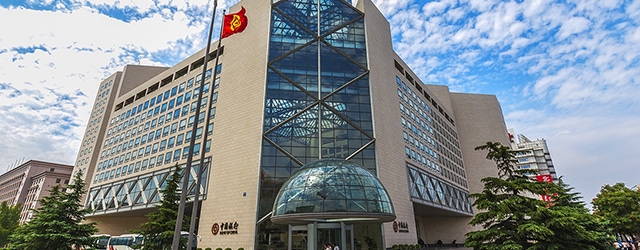With systemwide deleveraging on hold, the Chinese banking sector will resume its growth trajectory.

The trade dispute between the United States and China continues to escalate, with imposed tariffs of up to 25% on hundreds of billions of dollars in goods. This will exacerbate the already dismal growth expectations for the Chinese economy. The IMF is forecasting average growth below 6% from 2019 to 2023, below the government’s growth target of 6% to 6.5% for this year. Such pressures seem to be putting government efforts to bring down excess bank leverage on a back burner, yet there’s no rush to stimulus either.
China’s central bank, the People’s Bank of China (PBoC), indicated it would fine-tune policy rather than take dramatic measures, using a combination of monetary policy along with fiscal stimulus that typically involves the state-owned policy banks and large infrastructure projects. “We are not in a rush to ease like other central banks, [by] cutting interest rates or quantitative easing,” PBoC Governor Yi Gang said at a press conference in Beijing. “China’s monetary policy will remain prudent and consistent.”
To increase banking-system liquidity and spur growth, the central bank cut banks’ required reserve ratio in September—the third such cut in 2019; additional reductions are possible by year’s end. The PBoC has also changed its interest rate policy, introducing a new benchmark, the loan prime rate. It is intended to lower borrowing costs; however, as demand for credit remains weak, this impact may be limited. Other fiscal policy measures include increasing tax rebates to Chinese exporters. Potential currency weakness as a result of lowering interest rates could help offset the impact of tariffs.
There is considerable leverage in the Chinese economy, and the PBoC has taken debt-reduction measures. In particular, regional institutions such as Baoshang Bank in Inner Mongolia and the fast-growing Bank of Jinzhou—both of which recently needed significant government assistance—may be bellwethers for the sector. Many believe a wave of bank rescues lies ahead. Consequently, tighter monetary policy and its intended effect of deleveraging the economy appears to be on hold in favor of stimulus measures to support growth. Additionally, the PBoC has implemented policy changes designed to liberalize the financial sector. These include lifting restrictions on foreign ownership of securities, insurance and fund management firms as of 2020, a move previously planned for 2021.
The large state-owned policy banks and commercial banks remain at the top of our rankings of the Safest Banks in China. Their positions are largely unchanged and include A-rated banks. The next group in our rankings includes a number of the joint-stock commercial banks, which are generally rated in the BBB range. The remaining institutions represent banks that are classified as rural and city banks and are split-rated, with a few having noninvestment-grade ratings. There are some changes in our rankings, as Industrial Bank rose three places (to 14th place) following an upgrade by Fitch based on increased systemic importance above other midtier banks, increasing the likelihood of state support if necessary. Bank of Ningbo rose four spots (to 17th place), reflecting a Moody’s upgrade based on an improved fundamental credit profile, as well as a strong level of implied support from the government of China.
Methodology
The scoring methodology for the Safest Chinese Banks follows that used in our other Safest Banks rankings. A rating of AAA is assigned a score of 10 points, AA+ receives nine points, down to BBB- worth one point and BB+ worth -1 point, and so on. When a bank has only two ratings, an implied score for the third rating is calculated by taking the average of the other two and deducting one point. When a bank has only one rating, an implied score for the second rating is calculated by deducting one point from the actual rating, and an implied score for the third rating is calculated by deducting two points from the actual rating.
|
China’s Top 25 Safest Banks |
|---|
|
Rank |
Company Name |
Fitch |
Moody’s |
S&P |
Total Score |
Assets ($ Mil.) |
Statement Date | |
|
1 |
China Development Bank |
A+ |
A1 |
A+ |
18 |
2,360,984 |
31-Dec-2018 | |
|
2 |
Agricultural Development Bank of China |
A+ |
A1 |
A+ |
18 |
996,451 |
31-Dec-2018 | |
|
3 |
The Export-Import Bank of China |
A+ |
A1 |
A+ |
18 |
609,840 |
31-Dec-2018 | |
|
4 |
Industrial and Commercial Bank of China |
A |
A1 |
A |
16 |
4,041,958 |
31-Dec-2018 | |
|
5 |
China Construction Bank Corporation |
A |
A1 |
A |
16 |
3,388,690 |
31-Dec-2018 | |
|
6 |
Agricultural Bank of China |
A |
A1 |
A |
16 |
3,299,208 |
31-Dec-2018 | |
|
7 |
Bank of China |
A |
A1 |
A |
16 |
3,103,353 |
31-Dec-2018 | |
|
8 |
Hang Seng Bank (China) |
NR |
A2 |
A+ |
15.5 |
12,833 |
31-Dec-2018 | |
|
9 |
Bank of Communications |
A |
A2 |
A— |
14 |
1,390,803 |
31-Dec-2018 | |
|
10 |
China Merchants Bank |
BBB+ |
A3 |
BBB+ |
10 |
984,347 |
31-Dec-2018 | |
|
11 |
China CITIC Bank Corporation |
BBB |
Baa2 |
BBB+ |
7 |
885,264 |
31-Dec-2018 | |
|
12 |
Shanghai Pudong Development Bank |
BBB |
Baa2 |
BBB |
6 |
917,789 |
31-Dec-2018 | |
|
13 |
China Everbright Bank |
NR |
Baa2 |
NR |
5 |
635,828 |
31-Dec-2018 | |
|
14 |
Industrial Bank |
BBB— |
Baa2 |
NR |
3.5 |
979,375 |
31-Dec-2018 | |
|
15 |
Guangzhou Rural Comm Bank |
NR |
Baa2 |
BBB— |
3.5 |
113,751 |
30-Jun-2018 | |
|
16 |
Bank of Shanghai |
NR |
Baa2 |
NR |
3 |
289,606 |
30-Jun-2018 | |
|
17 |
Bank of Ningbo |
NR |
Baa2 |
NR |
3 |
162,471 |
30-Jun-2018 | |
|
18 |
Shanghai Rural Commercial Bank |
NR |
NR |
BBB |
3 |
108,708 |
31-Dec-2016 | |
|
19 |
Ping An Bank |
BB+ |
Baa3 |
NR |
0.5 |
498,846 |
31-Dec-2018 | |
|
20 |
Bank of Nanjing |
NR |
Baa3 |
NR |
0 |
180,162 |
30-Jun-2018 | |
|
21 |
Bank of Chongqing |
NR |
Baa3 |
BBB— |
0 |
64,649 |
31-Dec-2017 | |
|
22 |
China Minsheng Banking Corp. |
BB+ |
NR |
BBB— |
-1 |
874,773 |
31-Dec-2018 | |
|
23 |
Hua Xia Bank |
BB+ |
NR |
BBB— |
-1 |
391,154 |
31-Dec-2018 | |
|
24 |
China Guangfa Bank |
BB+ |
Baa3 |
NR |
-1 |
344,499 |
31-Dec-2018 | |
|
25 |
Bank of Beijing |
BB+ |
NR |
NR |
-6 |
375,436 |
31-Dec-2018 | |
|
Asset figures from Fitch, Moody’s, and company reports. | ||||||||



